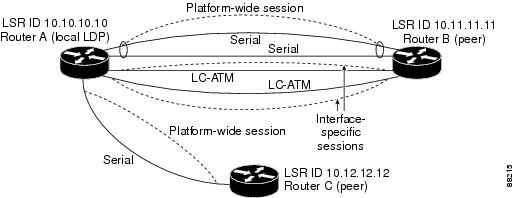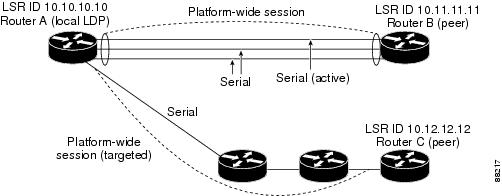ATM
-- Asynchronous Transfer Mode. The international standard for cell relay in which multiple service types (such as voice, video,
or data) are conveyed in fixed-length (53-byte) cells. Fixed-length cells allow cell processing to occur in hardware, thereby
reducing transit delays. ATM is designed to take advantage of high-speed transmission media, such as E3, SONET, and T3 .
downstream-on-demand distribution --A label distribution method in which a downstream label switch router (LSR) sends a binding upstream only if the upstream
LSR requests it.
downstream unsolicited distribution --A label distribution method in which labels are dispersed if a downstream label switch router (LSR) needs to establish a
new binding with its neighboring upstream LSR. For example, an edge LSR might enable a new interface with another subnet.
The LSR then announces to the upstream router a binding to reach this network.
informs
--A type of notification message that is more reliable than a conventional trap notification message, because the informs
message notification requires acknowledgment, but a trap notification does not.
label
--A short, fixed-length data identifier that tells switching nodes how to forward data (packets or cells).
label distribution --The techniques and processes that are used by label switch routers (LSRs) to exchange label binding information for supporting
hop-by-hop forwarding along normally routed paths.
LDP
--Label Distribution Protocol. The protocol that supports Multiprotocol Label Switching (MPLS) hop-by-hop forwarding and the
distribution of bindings between labels and network prefixes.
LSP
--label switched path. A configured connection between two label switch routers (LSRs) in which label-switching techniques
are used for packet forwarding; also a specific path through an Multiprotocol Label Switching (MPLS) network.
LSR
--label switch router. A Multiprotocol Label Switching (MPLS) node that can forward native Layer 3 packets. The LSR forwards
a packet based on the value of a label attached to the packet.
MIB
--Management Information Base. A database of network management information that is used and maintained by a network management
protocol such as Simple Network Management Protocol (SNMP). The value of a MIB object can be changed or retrieved by the use
of SNMP commands, usually through a network management system. MIB objects are organized in a tree structure that includes
public (standard) and private (proprietary) branches.
MPLS
--Multiprotocol Label Switching. A switching method for the forwarding of IP traffic through the use of a label. This label
instructs the routers and the switches in the network where to forward the packets based on preestablished IP routing information.
MPLS label distribution --A constraint-based routing algorithm for routing label-switched path (LSP) tunnels.
NMS
--network management station. A powerful, well-equipped computer (typically an engineering workstation) that is used by a
network administrator to communicate with other devices in the network. An NMS is typically used to manage network resources,
gather statistics, and perform a variety of network administration and configuration tasks. In the context of Simple Network
Management Protocol (SNMP), an NMS is a device that performs SNMP queries to the SNMP agent of a managed device to retrieve
or modify information.
notification
--A message sent by a Simple Network Management Protocol (SNMP) agent to a network management station, console, or terminal
to indicate that a significant network event has occurred. See also trap.
RSVP
--Resource Reservation Protocol. A protocol that supports the reservation of resources across an IP network. Applications
running on IP end systems can use RSVP to indicate to other nodes the nature of the packet streams they want to receive by
specifying such items as bandwidth, jitter, and maximum burst.
RTR
--Response Time Reporter. A tool that allows you to monitor network performance, network resources, and applications by measuring
response times and availability.
SNMP
--Simple Network Management Protocol. A network management protocol used almost exclusively in TCP/IP networks. SNMP enables
a user to monitor and control network devices, manage configurations, collect statistics, monitor performance, and ensure
network security.
SNMP communities --Authentication scheme that enables an intelligent network device to validate SNMP requests.
SNMPv2c
--Version 2c of the Simple Network Management Protocol. SNMPv2c supports centralized as well as distributed network management
strategies and includes improvements in the Structure of Management Information (SMI), protocol operations, management architecture,
and security.
SNMPv3
--Version 3 of the Simple Network Management Protocol. Interoperable standards-based protocol for network management. SNMPv3
provides secure access to devices by a combination of authenticating and encrypting packets over the network.
TLV
--Type-Length-Value. A mechanism used by several routing protocols to carry a variety of attributes. Cisco Discovery Protocol
(CDP), Label Discovery Protocol (LDP), and Border Gateway Protocol (BGP) are examples of protocols that use TLVs. BGP uses
TLVs to carry attributes such as Network Layer Reachability Information (NLRI), Multiple Exit Discriminator (MED), and local
preference.
trap
--A message sent by a Simple Network Management Protocol (SNMP) agent to a network management station, console, or terminal
to indicate that a significant network event has occurred. Traps (notifications) are less reliable than inform requests, because
the receiver of the trap does not send an acknowledgment of receipt; furthermore, the sender of the trap cannot determine
if the trap was received. See also notification.
VCC
--virtual channel connection. A logical circuit, made up of virtual channel links (VCLs), that carries data between two endpoints
in an ATM network. Sometimes called a virtual circuit connection.
VCI
--virtual channel identifier. A 16-bit field in the header of an ATM cell. The VCI, together with the virtual path identifier
(VPI), is used to identify the next network virtual channel link (VCL) as the cell passes through a series of ATM switches
on its way to its final destination.
VCL
--virtual channel link. The logical connection that exists between two adjacent switches in an ATM network.
VPI
--virtual path identifier. An 8-bit field in the header of an ATM cell. The VPI, together with the virtual channel identifier
(VCI), is used to identify the next network virtual channel link (VCL) as the cell passes through a series of ATM switches
on its way to its final destination.
VPN
--Virtual Private Network. A network that enables IP traffic to use tunneling to travel securely over a public TCP/IP network.
VRF
--VPN routing and forwarding instance. A VRF consists of an IP routing table, a derived forwarding table, a set of interfaces
that use the forwarding table, and a set of rules and routing protocols that determine what goes into the forwarding table.
In general, a VRF includes the routing information that defines a customer VPN site that is attached to a PE router.











 Feedback
Feedback